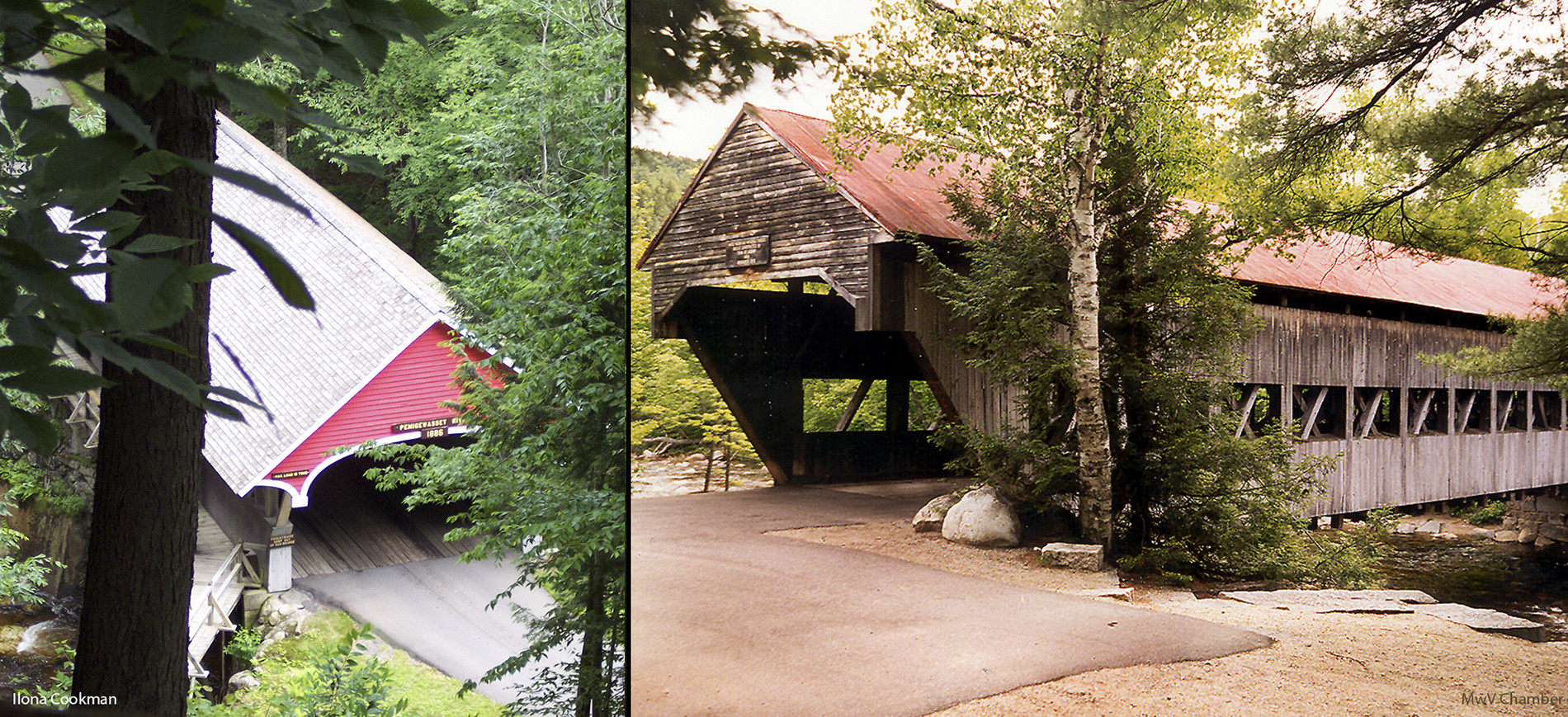17 Harriman Rd Jackson, NH 03838
Main St Jackson, NH 03838
Bartlett, NH
Albany, NH
Conway, NH
Conway, NH
Ossipee, NH 03886
Sandwich, NH 03259
One of the most charming of these bridges spans the Ellis River at the entrance into Jackson village. This “honeymoon” or “kissing bridge” received its nickname from the tradition of lovers kissing under it for good luck. Jackson’s endearing symbol for over a century, the Paddleford truss bridge was constructed about 1876 by Charles Broughton and his son Frank. According to town records, the sidewalk was added in 1930. Originally, the trusses were more exposed than they are today. The Honeymoon Bridge is a well cared for and celebrated entryway into Jackson village.
Leaving Jackson, go south to Route302 and then east toward Bartlett to another Paddleford truss bridge, this one with additional arches. Constructed in 1851 and now privately owned, the Bartlett Bridge is unique among all the bridges in New Hampshire because its function has been changed from roadway to retail store. The bridge was abandoned and closed to traffic in 1939. It was later rebuilt, and for the past 20 years has housed a gift shop within the bridge structure.
Continuing towards the town of Bartlett, take a left onto the Bear Notch Road, a three season backcountry road (closed in winter) which provides a shortcut through the notch to the world-famous Kancamaugus Highway. At the eastern end of the route as you come off Bear Notch Road, lies the Albany Bridge over the Swift River. The first bridge on this site was constructed in 1857 and destroyed by a windstorm in 1858. The ‘new’ bridge, built in 1858, has wide shallow arches and sharply raked facades. If you’re looking for wildlife, you may be in luck and see a moose has emerged from a nearby marsh!
Continue east on Route 112 (the Kancamaugus Highway) to the stoplight where Route 112 intersects Route 16. Follow Route 16 north to the next set of lights, which is in the village of Conway. Turn left onto Washington Street to enjoy two Paddleford truss bridges within sight of one another. You’ll find a perfect picnic site to enjoy lunch at the Saco River Bridge, which was reconstructed after spring flood waters floated the original structure downstream into the Swift River Bridge destroying them both. Remnants of both bridges were used to rebuild the Swift River Bridge (1870) which can be seen from your picnic table site. The Saco bridge was reconstructed again in 1890 after a fire. For the adventuresome, a climb to the riverbank on the upstream side will offer good views of both bridges looking down this narrow, babbling river.
You can find your next destination by turning right to get back on Route16 south or you can continue straight at the lights on Route 113 and wind through the backcountry on “a road less traveled.” This road returns you to Route16 south in Chocorua and you will go south to the Whittier bridge in West Ossippee, west of Route 16 on old Route 125 over the Bearcamp River. The Whittier Bridge which was named after the popular 19th century poet, John Greenleaf Whittier. A bridge has stood at this site for over two centuries, although rebuilt many times until the current bridge was built in the 1870s. At that time, the well used span was the main thoroughfare in a busy neighborhood. In the 1980s, a summer resident had the bridge restored in memory of his wife, Nancy Sheldon Pope. paid for its restoration in memory of his wife. The sides of the Whittier Bridge were originally closed with the exception of tiny windows, but were opened as part of the restoration.
The most remote of these historic bridges is well worth the trip- the Durgin Bridge is the third one to be built at the Cold River. The first bridge constructed at this site was built to replace the ford, located nearly a quarter mile upstream. The current 1869 bridge is the fourth structure on the site, and is believed to have been part of the” underground railroad” for slaves fleeing from the south and heading to Canada. To visit this historic structure, follow Route 25 west from West Ossipee and turn right into Sandwich on Route 113. From Route 113 in Sandwich go north on Durgin Road which is two miles east of North Sandwich village for 1.5 miles to the bridge. This is a pleasant journey, especially during foliage season when the red leaves are floating on the rivers. Return home on Route 16 north to Jackson after a nostalgic trip into the nineteenth century.
Additional information about all of these bridges is available at the official New Hampshire website.






